Reliability-Aware Cooperative Node Sleeping and Clustering in Duty-Cycled Sensors Networks
Abstract
:1. Introduction
- The PFs’ selection strategy of traditional beaconless geo-routing relies on the shape and size of a certain sensory data forwarding region. However, the number of PFs in the forwarding region for each relay node (RN) is uncertain, and it fluctuates from hop to hop. Although some nodes have a relatively large number of PFs, the ETE reliability still cannot be guaranteed because some “bottleneck” hop has very few PFs. Compared to the beaconless geo-routing, the RCR-selection always ensure k cooperative nodes at each hop, to improve personalized ETE reliability.
- Similar to the time division multiple access (TDMA-like) approach, the time slots of RCR-delivery are allocated by reference nodes (RN) in a centralized scheme before data transmission from one hop to the next hop. Simulation results showed that every time slot should be as short as possible. However, we should guarantee that PFs can receive data packets from other higher priority PFs before their timer expires. Thus, the value of each predetermined time slot should be long enough to accommodate the hop delay at least. Therein, a hop delay denotes the elapsed time from the moment a sensor node sends a data packet (to its farthest neighbor node) to the moment when a neighbor node receives it. Different from the three hand-shaking mechanism of beaconless geo-routing, the RCR-delivery performs with lower delay under the same packet delivery rate in order to avoid collision.
- In traditional beaconless geo-routing protocols, the current packet holder (PH) typically broadcasts a probe message to PFs and waits for a reply. After receiving the first reply, which shows that a PF will be the next packet holder, the current PH transmits the data packet to the candidate by unicast and release memory. Different from such a high cost data forwarding scheme, the RCR-delivery does not determine which packet holder will be the next candidate. In addition, due to the centralized forwarding delays allocation of cooperative nodes, the collision ratio of RCR-delivery can be ignored.
- In order to achieve a load balancing among in RCR, RN assigns priority to every cooperative node according to its residual energy information. In addition, almost all of the existing traditional beaconless geo-routing schemes cannot effectively guarantee network lifetime [6].
- Due to the dynamical scheduling of duty cycles of cooperative nodes, the RCR-delivery can guarantee on-demand ETE reliability while achieving energy efficiency. By comparison, almost none of the existing traditional beaconless geo-routing schemes can guarantee energy efficiency when transmitting sensory data because all of the PFs must be awake and stay active all the time to attend the election [7].
2. Related Works
2.1. Geographic Routing
2.2. Beaconless Geographic Routing
2.3. Cooperative Communications
3. Network Model
3.1. Cooperative Nodes Search Region
3.2. Selection of Cooperative Nodes
3.3. Selection of the Reference Node for the Next Hop
3.4. RCR Update
3.5. Multihop Cooperative Structure
4. On-Demand ETE Reliability Model
4.1. Probability Model for Successful Delivery in One Hop
4.2. Probability Model for ETE Successful Data Delivery
5. RCR Algorithm Design
| Algorithm 1 choosing algorithm. |
|
6. Performance Evaluation
6.1. The Impact of f and K
6.2. The Impact of k and on Reliability and ETE Delay in RCR
6.3. Performance Comparison among RCR, REER, BLR and GPSR
7. Conclusions
Acknowledgments
Author Contributions
Conflicts of Interest
References
- Li, D.; Xu, Y.; Wang, X.; Guizani, M. Coalitional game theoretic approach for secondary spectrum access in cooperative cognitive radio networks. IEEE Trans. Wirel. Commun. 2011, 10, 844–856. [Google Scholar] [CrossRef]
- Zhang, C.; Wang, X.; Li, J. Cooperative cognitive radio with priority queueing analysis. In Proceedings of the IEEE International Conference on Communications, Dresden, Germany, 14–18 June 2009. [Google Scholar]
- Kim, J.; Lee, H.W.; Chong, S. TAES: Traffic-Aware Energy-Saving Base Station Sleeping and Clustering in Cooperative Networks. In Proceedings of the 13th International Symposium on WiOpt, Mumbai, India, 25–29 May 2015. [Google Scholar]
- Liang, X.; Chen, M.; Balasingham, I.; Leung, V.C.M. Cooperative communications with relay selection for wireless networks: Design issues and applications. Wirel. Commun. Mob. Comput. 2013, 13, 745–759. [Google Scholar] [CrossRef]
- Park, J.; Yong, N.K.; Jin, Y.B. A forwarder selection method for greedy mode operation of a geographic routing protocol in a WSN. In Proceedings of the IEEE Fifth International Conference on Ubiquitous and Future Networks, Da Nang, Vietnam, 2–5 July 2013; pp. 270–275. [Google Scholar]
- Zhang, H.; Shen, H. Energy-efficient beaconless geographic routing in wireless sensor networks. IEEE Trans. Parallel Distrib. Syst. 2010, 21, 881–896. [Google Scholar] [CrossRef]
- Gao, C.; Zhang, W.; Tang, J.; Wang, C.; Zou, S.; Su, S. Relax, but Do Not Sleep: A New Perspective on Green Wireless Networking. In Proceedings of the IEEE INFOCOM, Toronto, ON, Canada, 27 April–2 May 2014; pp. 907–915. [Google Scholar]
- Chen, M.; Hao, Y.; Hu, L.; Huang, K.; Lau, V. Green and Mobility-aware Caching in 5G Networks. IEEE Trans. Wirel. Commun. 2017, 16, 8347–8361. [Google Scholar] [CrossRef]
- Alvi, A.N.; Bouk, S.H.; Ahmed, S.H.; Yaqub, M.A.; Sarkar, M.; Song, H. BEST-MAC: Bitmap-Assisted Efficient and Scalable TDMA-Based WSN MAC Protocol for Smart Cities. IEEE Access 2016, 4, 312–322. [Google Scholar] [CrossRef]
- Zhang, Y.; Chen, M.; Guizani, N.; Wu, D.; Leung, V.C.M. SOVCAN: Safety-Oriented Vehicular Controller Area Network. IEEE Commun. 2017, 55, 94–99. [Google Scholar] [CrossRef]
- Zhang, Y.; Tu, Z.; Wang, Q. TempoRec: Temporal-Topic Based Recommender for Social Network Services. Mob. Netw. Appl. 2017, 22, 1182–1191. [Google Scholar] [CrossRef]
- Tseng, F.; Cho, H.; Chou, L.; Shih, T.K.; Chao, H.C. An efficient power conservation scheme in non-zero-sum duty-cycle game for wireless sensor networks. Int. J. Sens. Netw. 2016, 21, 242–251. [Google Scholar] [CrossRef]
- Chen, M.; Leung, V.; Mao, S.; Kwon, T. Receiver-oriented load-balancing and reliable routing in wireless sensor networks. Wirel. Commun. Mob. Comput. 2009, 9, 405–416. [Google Scholar] [CrossRef]
- Karp, B.; Kung, H.T. GPSR: Greedy perimeter stateless routing for wireless networks. In Proceedings of the International Conference on Mobile Computing, Boston, MA, USA, 6–11 August 2000; pp. 243–254. [Google Scholar]
- Füßler, H.; Widmer, J.; Käsemann, M.; Mauve, M.; Hartenstein, H. Contention-based forwarding for mobile ad hoc networks. Ad Hoc Netw. 2003, 1, 351–369. [Google Scholar] [CrossRef]
- Heissenbuttel, M.; Braun, T.; Bernoulli, T.; Walchli, M. BLR: Beacon-Less Routing Algorithm for Mobile Ad Hoc Networks. Comput. Commun. 2004, 11, 1076–1086. [Google Scholar] [CrossRef]
- Chen, M.; Kwon, T.; Mao, S.; Yuan, Y. Reliable and energy-efficient routing protocol in dense wireless sensor networks. Int. J. Sens. Netw. 2008, 4, 104–117. [Google Scholar] [CrossRef]
- Razzaque, M.; Ahmed, M.; Hong, C.; Lee, S. QoS-aware distributed adaptive cooperative routing in wireless sensor networks. Ad Hoc Netw. 2014, 19, 28–42. [Google Scholar] [CrossRef]
- Nosratinia, A.; Hunter, T.E.; Hedayat, A. Cooperative communication in wireless networks. IEEE Commun. Mag. 2004, 42, 74–80. [Google Scholar] [CrossRef]
- Ahmed, S.H.; Wahid, A.; Kim, D. EENC-energy efficient nested clustering in UASN. In Proceedings of the 29th Annual ACM Symposium on Applied Computing, Gyeongju, Korea, 24–28 March 2014; pp. 706–710. [Google Scholar]
- Sanchez, J.A.; Ruiz, P.M.; Marin-Perez, R. Beacon-less geographic routing made practical: Challenges, design guidelines, and protocols. IEEE Commun. Mag. 2009, 47, 85–91. [Google Scholar] [CrossRef]
- Brar, G.S.; Rani, S.; Chopra, V.; Malhotra, R.; Song, H.; Ahmed, S.H. Energy Efficient Direction-Based PDORP Routing Protocol for WSN. IEEE Access 2016, 4, 3182–3194. [Google Scholar] [CrossRef]
- Hong, Y.-W.; Huang, W.-J.; Chiu, F.-H.; Kuo, C.-C. Cooperative communications in resource-constrained wireless networks. IEEE Signal Process. Mag. 2007, 24, 47–57. [Google Scholar] [CrossRef]
- Liu, P.; Tao, Z.; Lin, Z.; Erkip, E.; Panwar, S. Cooperative wireless communications: A cross-layer approach. IEEE Wirel. Commun. 2006, 13, 84–92. [Google Scholar]
- Zhang, Y.; Qiu, M.; Tsai, C.-W.; Hassan, M.M.; Alamri, A. Health-CPS: Healthcare Cyber-Physical System Assisted by Cloud and Big Data. IEEE Syst. J. 2017, 11, 88–95. [Google Scholar] [CrossRef]
- Chen, M.; Hao, Y.; Hwang, K.; Wang, L.; Wang, L. Disease Prediction by Machine Learning over Big Healthcare Data. IEEE Access 2017, 5, 8869–8879. [Google Scholar] [CrossRef]
- Alvi, A.N.; Bouk, S.H.; Ahmed, S.H.; Yaqub, M.A.; Javaid, N.; Kim, D. Enhanced TDMA based MAC protocol for adaptive data control in wireless sensor networks. J. Commun. Netw. 2015, 17, 247–255. [Google Scholar] [CrossRef]
- Mao, S.; Lin, S.; Panwar, S.; Wang, Y.; Celebi, E. Video transport over ad hoc networks: Multistream coding with multipath transport. IEEE J. Sel. Areas Commun. 2003, 21, 1721–1737. [Google Scholar]
- Fang, J.; Che, Z.; Yu, X.; Chen, Z.; Jiang, Z.L. Capacity-achieving and Flicker-free FEC coding scheme for Dimmable Visible Light Communication Based on Polar Codes. IEEE Photonics J. 2016, 9, 1–10. [Google Scholar]
- Chen, M.; Hao, Y.; Qiu, M.; Song, J.; Wu, D.; Humar, I. Mobility-aware Caching and Computation Offloading in 5G Ultradense Cellular Networks. Sensors 2016, 16, 974. [Google Scholar] [CrossRef] [PubMed]
- Chen, M.; Wang, X.; Wang, J.; Wu, D.; Li, Y. KCN: Guaranteed Delivery via K-Cooperative-Nodes in Duty-Cycled Sensor Networks. In Proceedings of the IEEE 12th International Conference on Mobile Ad Hoc and Sensor Systems (MASS), Dallas, TX, USA, 19–22 October 2015; pp. 449–451. [Google Scholar]
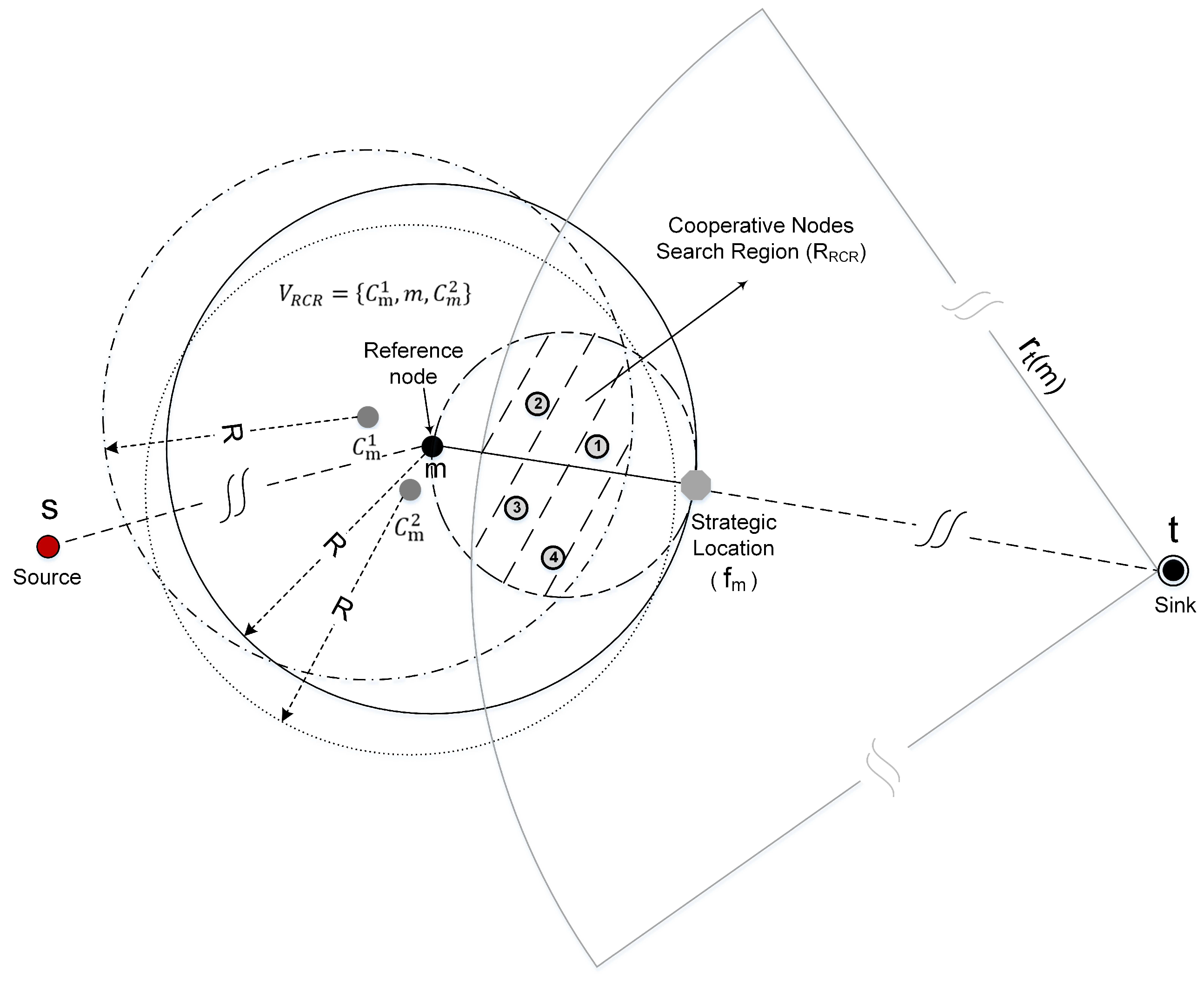
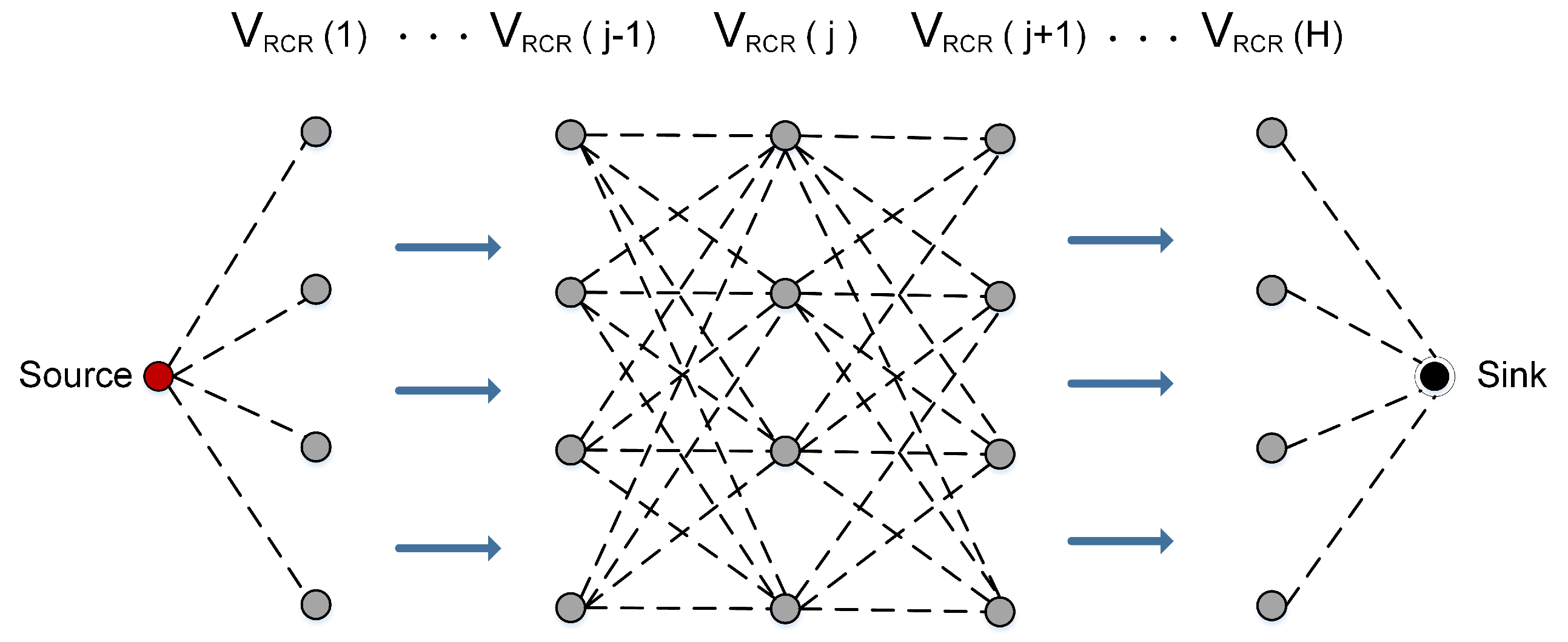

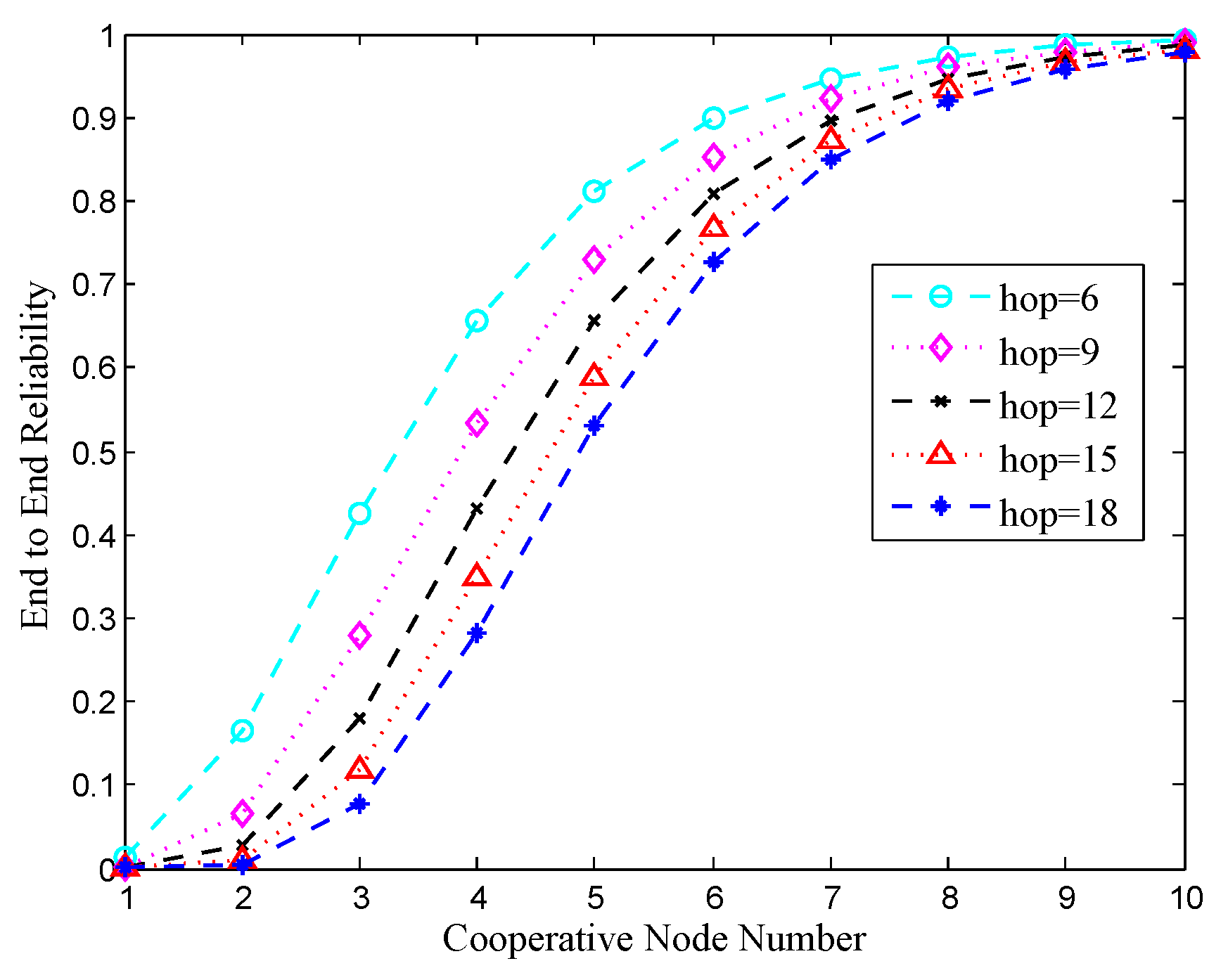

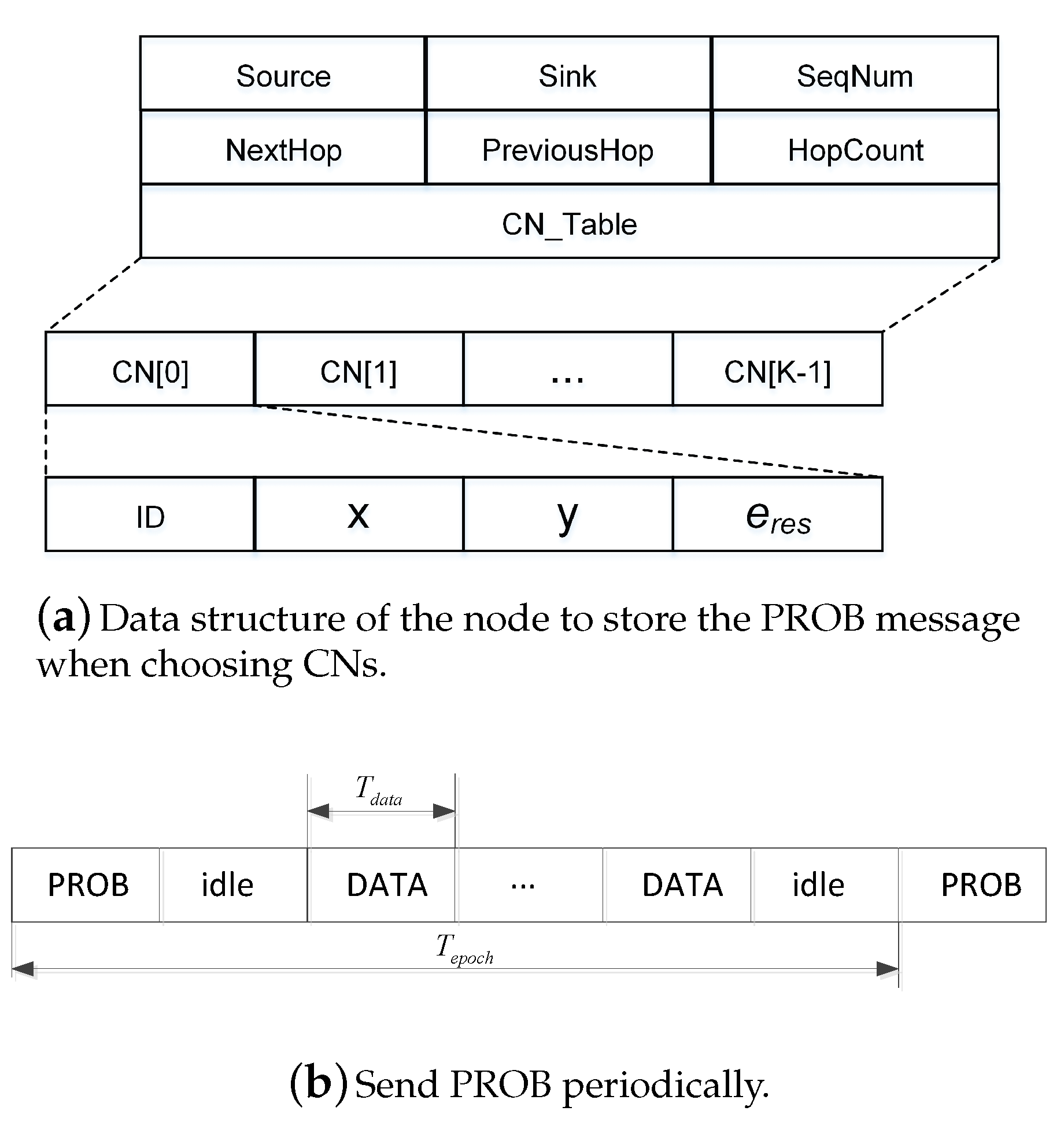
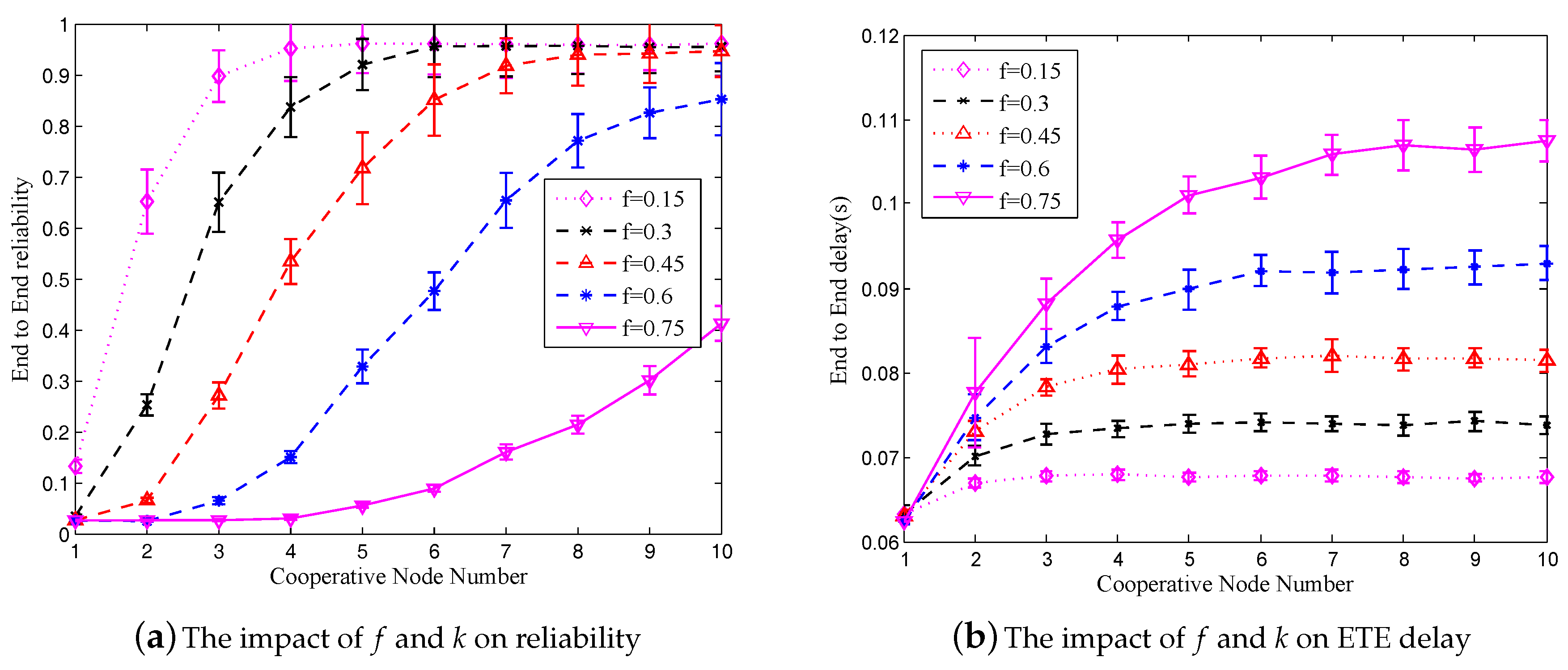
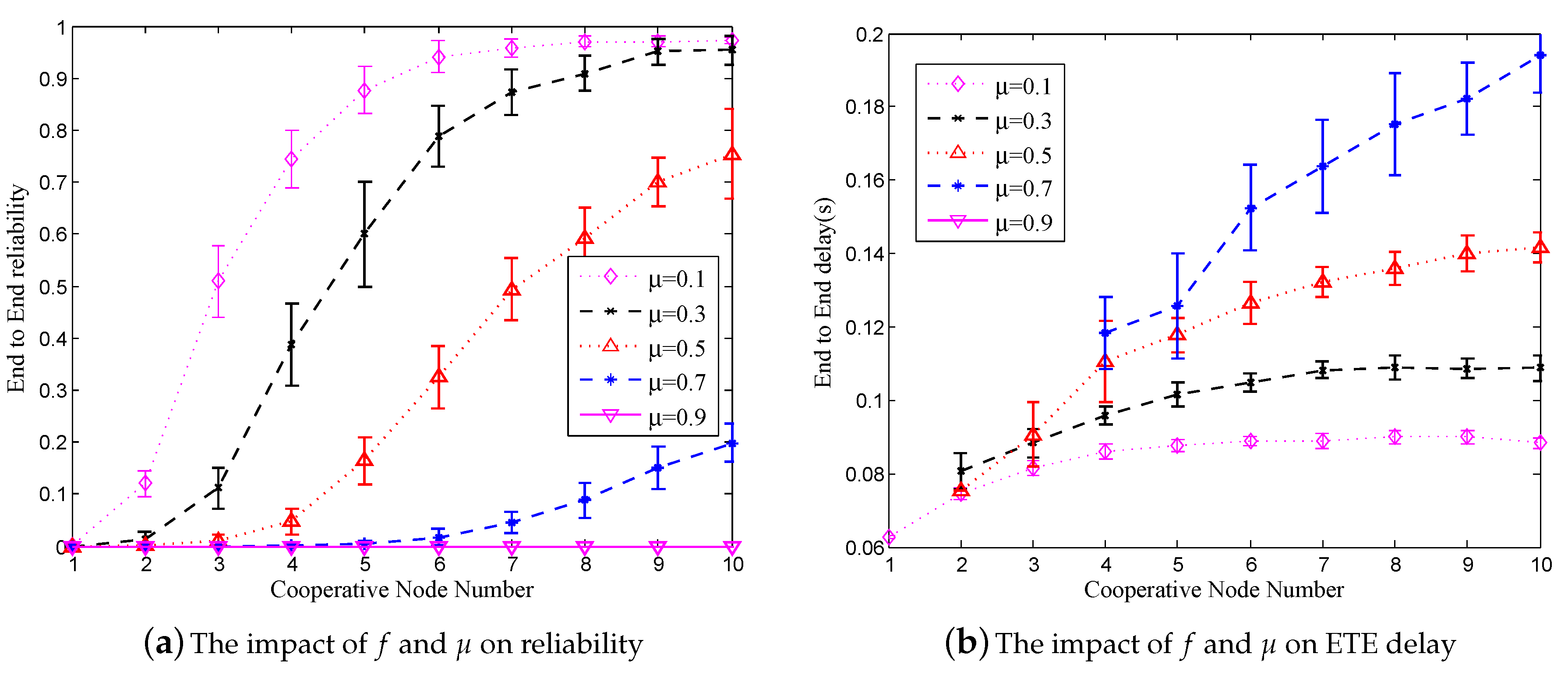
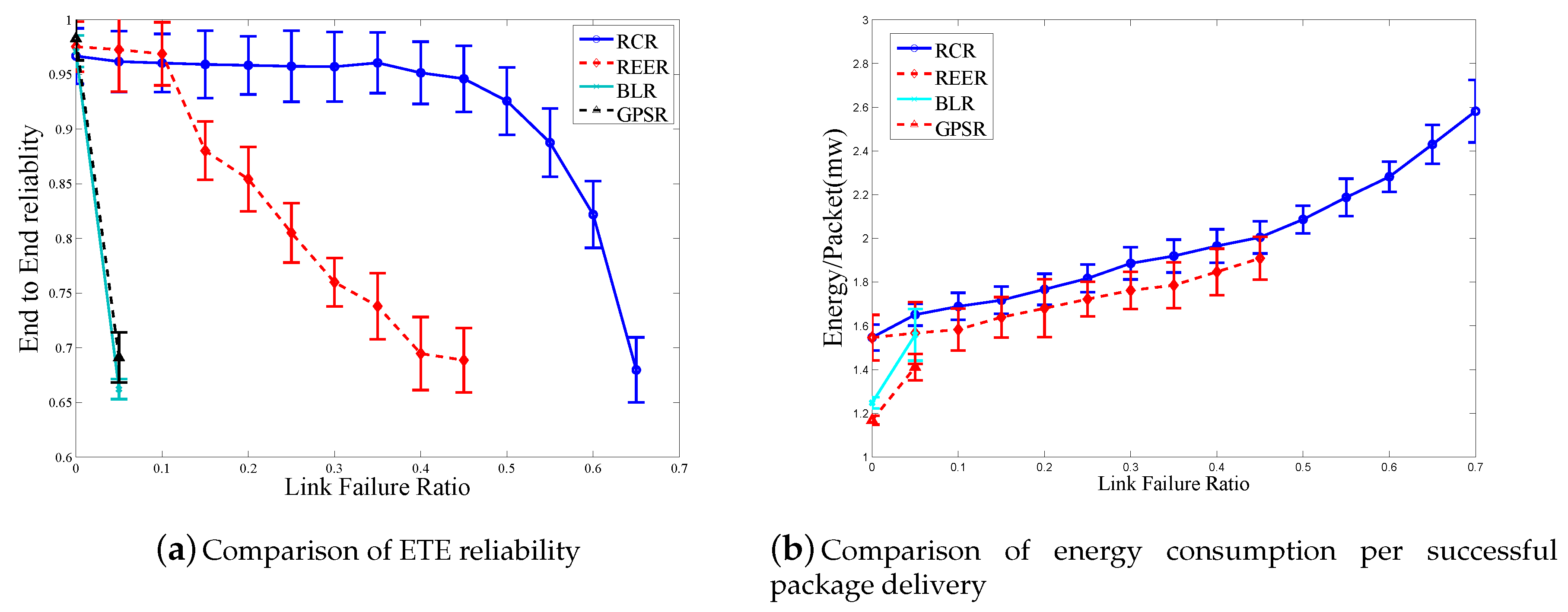
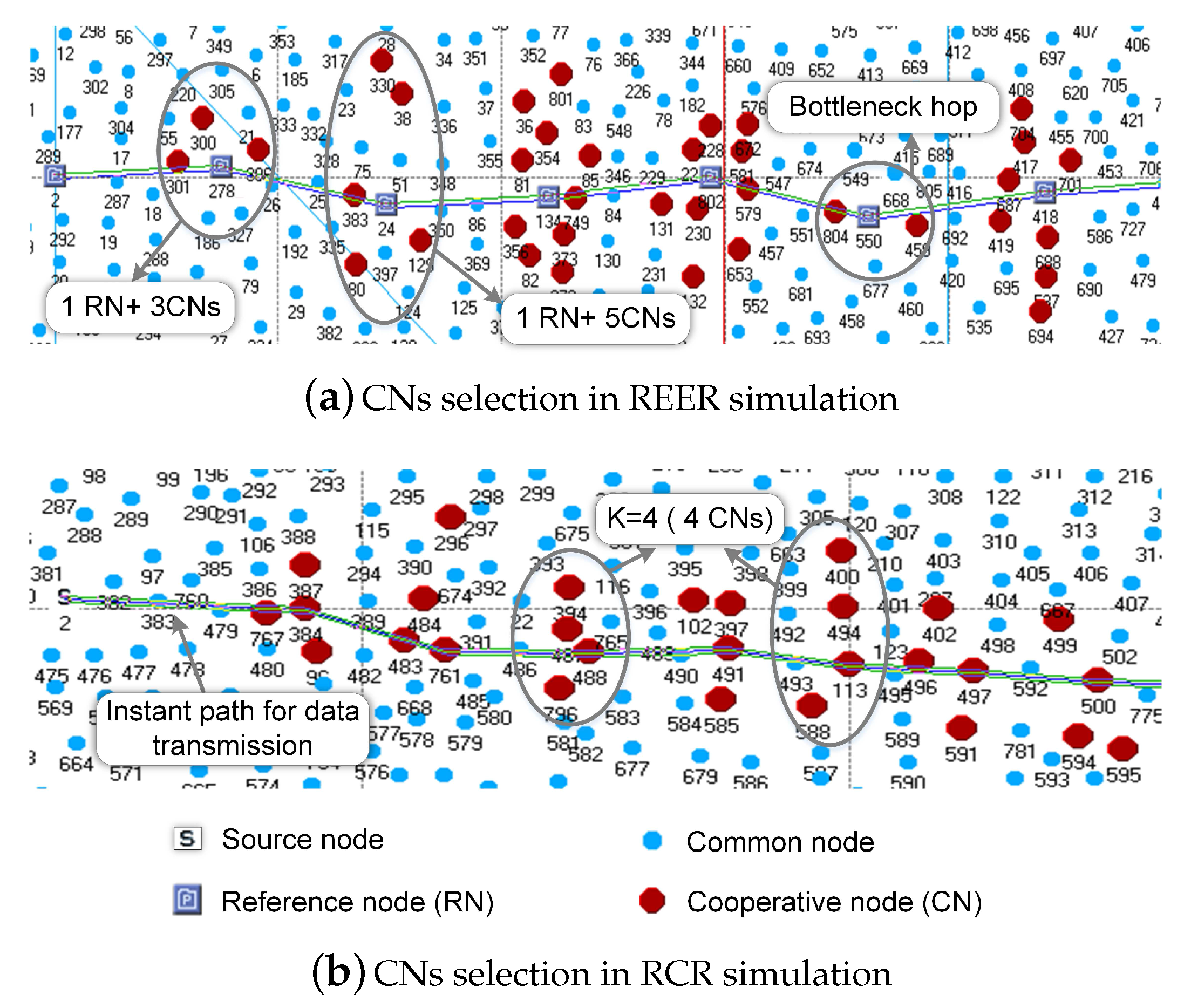
| Symbol | Definition |
|---|---|
| s | source node, |
| t | sink node, |
| H | hop count between the source node and the sink node, |
| f | link failure rate, |
| node density, | |
| R | transmission range, |
| the distance between nodes u and v, | |
| K | the total number of cooperative nodes at each hop, |
| k | the number of awake cooperative nodes at each hop, |
| reliability-aware cooperative routing, | |
| RCR construction cost per time, | |
| RCR construction refreshing interval, | |
| duty cycle of sensors, | |
| the probability with k number of | |
| awake cooperative nodes among RCR, | |
| reference node at hop i, or | |
| , | |
| the cooperative neighbor nodes of , | |
| cooperative nodes search region, | |
| the disk centered at sink t with radius | |
| where , | |
| the disk centered at the middle node | |
| between m and with radius , | |
| the total number of neighbor nodes of m, | |
| , | |
| the cooperative nodes at hop i, | |
| energy level of sensor node, | |
| given k available cooperative nodes, | |
| successful delivery ration at hop i, | |
| W | end-to-end (ETE) reliability |
| Items | GPSR | BLR | REER | RCR |
|---|---|---|---|---|
| Categories | Stateful geo-routing protocol | Stateless routing protocol | Reliable and energy-efficient routing | Reliability-aware cooperative routing |
| Features | Waste communication resource; significant energy consumption | Acknowledgment collision; worse robustness of forwarding, latency and energy efficiency | Relaying candidate selection is independent from data flow; significant communication overhead | Adaptive in dynamic network environments; control energy consumption; guarantee ETE reliability |
| Related Works | Receiver-oriented load-balancing and reliable routing in wireless sensor networks [13]; GPSR: greedy perimeter stateless routing for wireless networks [14] | Contention-based forwarding for mobile ad hoc networks [15]; BLR: Beacon-Less Routing Algorithm for Mobile Ad Hoc Networks [16] | Reliable and energy-efficient routing protocol in dense wireless sensor networks [17] | QoS-aware distributed adaptive cooperative routing in wireless sensor networks [18]; Cooperative communication in wireless networks [19] |
© 2018 by the authors. Licensee MDPI, Basel, Switzerland. This article is an open access article distributed under the terms and conditions of the Creative Commons Attribution (CC BY) license (http://creativecommons.org/licenses/by/4.0/).
Share and Cite
Song, J.; Miao, Y.; Song, E.; Hossain, M.S.; Alhamid, M.F. Reliability-Aware Cooperative Node Sleeping and Clustering in Duty-Cycled Sensors Networks. Sensors 2018, 18, 127. https://doi.org/10.3390/s18010127
Song J, Miao Y, Song E, Hossain MS, Alhamid MF. Reliability-Aware Cooperative Node Sleeping and Clustering in Duty-Cycled Sensors Networks. Sensors. 2018; 18(1):127. https://doi.org/10.3390/s18010127
Chicago/Turabian StyleSong, Jeungeun, Yiming Miao, Enmin Song, M. Shamim Hossain, and Mohammed F. Alhamid. 2018. "Reliability-Aware Cooperative Node Sleeping and Clustering in Duty-Cycled Sensors Networks" Sensors 18, no. 1: 127. https://doi.org/10.3390/s18010127





